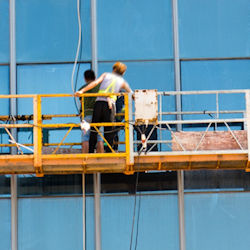22.D Wood Pole Scaffolds.
> See 29 CFR 1926.452(a).
22.E Suspended Scaffolds.
22.E.01 Suspended scaffolds are scaffolds that are suspended from anchorage points/hoists that allow the scaffold to move up and down as needed for work to be performed. Suspended scaffolds must be designed, constructed, operated, inspected, tested, and maintained as specified in the operating manual for the device.
22.E.02 Inspections.
- Suspended scaffold systems must be inspected prior to being placed in service to determine that the system conforms to this manual and the manufacturer's specifications.
- Before the scaffold is used, direct connections must be evaluated by a CP who must confirm, based on the evaluation, that the supporting surfaces are capable of supporting the loads imposed.
- Each hoist must be inspected by a CP before use, after every installation and re-rigging in accordance with the manufacturer's specifications. A trial operation will be done by the operator alone after every installation.
- Connection and anchorage systems of suspended scaffold must be inspected at the beginning of each shift.
- All wire ropes, fiber and synthetic ropes, slings, hangers, hoists, rigging, fall protection equipment, platforms, anchorage points and their connections, and other supporting parts must be inspected before every installation, daily thereafter, and periodic while the scaffold is in use.
- Governors and secondary brakes for powered hoists must be inspected and tested per the manufacturer's recommendations: at the minimum, inspections must be made annually.
- (1) Inspections and tests must include a verification that the initiating device for the secondary braking operates as intended.
- (2) A copy of the latest inspection and test report must be maintained on the job site.
- Records of inspections conducted while the unit is at the work site must be maintained at the work site.
22.E.03 Only personnel trained in the use of the suspended work platform must be authorized to operate it. Anyone involved in erecting, disassembling, moving, operating, using, repairing, maintaining or inspecting a suspended scaffold must be trained by a CP to recognize any hazards associated with the work in question. Proof of training must be maintained on site and made available to the GDA upon request. Training must include:
- Reading and understanding the manufacturer's operating manual and any associated rules and instructions, or training by a QP on the contents on these documents, and
- Reading and understanding all decals, warnings, and instructions on the device.
22.E.04 All parts of all suspended scaffolds must have a minimum safety factor of 4. A minimum safety factor of 6 is required for support ropes.
22.E.05 Support ropes.
- Support ropes must be attached at the vertical centerline of the outrigger and the attachment must be directly over the hoist machine.
- Support ropes must be vertical for their entire length. The scaffold must not be swayed nor the support ropes fixed to any intermediate points to change the original path of travel.
- Support ropes must have the fixed end equipped with a proper size thimble and secured by eye splicing or equivalent means. Free ends must be brazed or secured to prevent fraying.
- The wire rope for traction hoists must be of such length that the operator may descend to the lowest point of travel without the end of the wire rope entering the hoist. Where the wire rope is inadequate for the lowest descent, provision must be made to prevent the hoist from running off the wire rope.
- On winding drum type hoists, running ends of suspension ropes must be attached by positive means to the hoisting drum and at least four wraps of the rope must remain on the drum at all times.
- Support ropes must be capable of resisting chemicals or conditions to which they are exposed.
- No welding, burning, riveting, or open flame work must be performed on any platform suspended by fiber or synthetic rope.
- Defective or damaged rope must not be used as lifelines or suspension lines. The repairing of wire rope is prohibited.
22.E.06 All suspension scaffold support devices such as outrigger beams, cornice hooks, parapet clamps, or similar devices must:
- Be made of mild steel, wrought iron, or materials of equivalent strength;
- Be supported by bearing blocks;
- Rest on surfaces capable of supporting the reaction forces imposed by the scaffold hoist operating at its maximum rated load; and
- Be secured against movement by tiebacks installed at right angles to the face of the building whenever possible and secured to a structurally sound portion of the building. Tiebacks must be equivalent in strength to the hoisting rope.
Knowledge Check Choose the best answer for the question.
22-7. What is the minimum safety factor for support ropes?
You forgot to answer the question!

